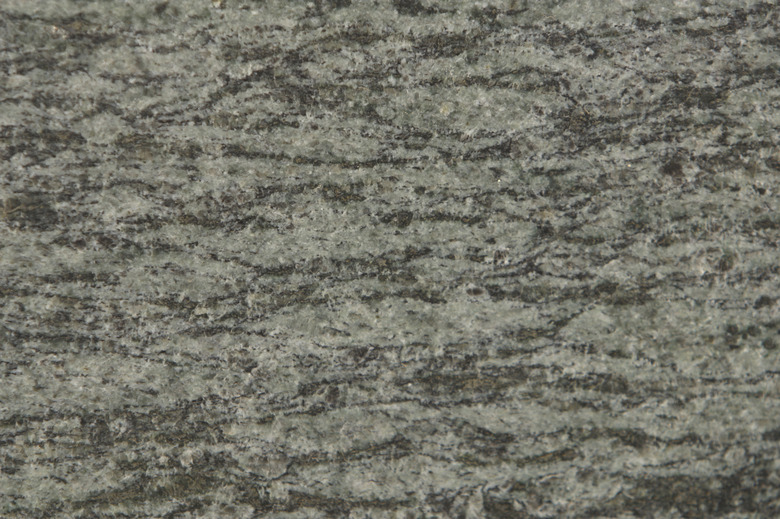Characteristics Of Intrusive Rocks
Igneous rocks are extrusive and intrusive. Extrusive rocks are formed from magma above the surface, while intrusive igneous rocks form from magma beneath the surface. The cooling process may be fast or slow, and determines the color and texture of the intrusive rock. Intrusive rocks also form large masses on land such as batholiths, dikes and sills.
Formation
Formation
Intrusive rocks are formed from magma deep in the earth. Magma cools more slowly there and thus the cooling history of intrusive rocks is longer, allowing the formation of larger crystals than those produced at the surface, where cooling is quicker. These large crystals give the intrusive rock a phaneritic texture, or the ability to be seen with the unaided eye. Intrusive rocks are composed of crystals so large it's possible to see within them the interlocking of individual crystals.
Texture
Texture
Rock textures refer to crystal characteristics visible with the unaided eye. The texture of intrusive rock depends on its cooling history. Coarse-grained rocks result from slow cooling. Two phases of cooling, the first slow and the second rapid, results in porphyritic rock, which has a coarse grain as well. Pegmatitic textured rock forms when slow cooling combines with high water content. The textures of intrusive rocks formed from volcanic ash are categorized based on their content including bubbles and volcanic debris. Bubbles caused by low gas content form vesicular and amygdaloidal textures, which are somewhat porous. The pyroclastic texture is formed from volcanic debris, large and small, erupted from the volcano.
Color
Color
Igneous rocks are categorized by light, medium and dark colors. These colors correspond to felstic, intermediate and mafic, which indicate the amount of mafic materials — chiefly magnesium and iron — in an igneous rock. Various colors exist amongst the ultramafic rocks such as peridotite, which is a dark green. Intrusive igneous rocks represent colors from across the color index. Gabbro and basalt are mafic, granite is felsic, and diorite is intermediate.
Intrusive Rock Formations
Intrusive Rock Formations
Tabular and massive plutons are intrusive rock formations, each with specific characteristics. Tabular plutons are shaped in sheets but massive plutons are simply masses of intrusive rock with balanced dimensions. Tabular plutons include sills, laccoliths and dikes. They're formed when magma interacts with sedimentary beds. Sometimes, as with dikes, magma enters cracks forming a vertical sheet. Other times, horizontal sheets, such as sills, form. Laccoliths are similar to sills but face upward. Massive plutons include stocks and batholiths. Stocks are cooled magma chambers the size of mountains. Batholiths are combinations of magma chambers forced upwards, forming valleys between them which will eventually fill in.
Cite This Article
MLA
Harrison, Christopher. "Characteristics Of Intrusive Rocks" sciencing.com, https://www.sciencing.com/characteristics-intrusive-rocks-8739383/. 24 April 2017.
APA
Harrison, Christopher. (2017, April 24). Characteristics Of Intrusive Rocks. sciencing.com. Retrieved from https://www.sciencing.com/characteristics-intrusive-rocks-8739383/
Chicago
Harrison, Christopher. Characteristics Of Intrusive Rocks last modified March 24, 2022. https://www.sciencing.com/characteristics-intrusive-rocks-8739383/
